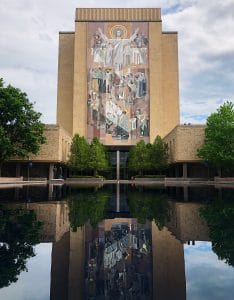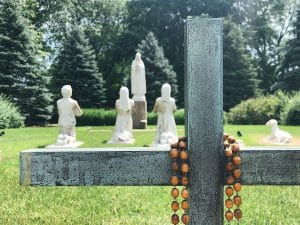On a brightly-lit morning in July 2020, the Verso team of five people walked across the eternally beautiful campus of the University of Notre Dame to reflect, share, and join together in a unique pilgrimage.
We have always talked about doing a pilgrimage from home, exploring the local and regional places where God has shown up through history.
But that morning’s pilgrimage was different. Namely, because it was the first pilgrimage any of us had gone on since early March, and most likely, would go on for the rest of the year.
In that way it was unusual, taking even just half a day for a pilgrimage, among a global landscape that was forcing our small ministry to forego pilgrimage indefinitely.
Before we set off there were questions: would it feel like a “true” pilgrimage? Would we be able to enter into a spiritual place that’s separate from our day-to-day lives? Would it bring us together in this unprecedented time?
The answer to all those questions was a resounding “yes.”
5 Sacred Sites of a Pilgrimage to Notre Dame — Bringing the World Home
Verso is currently focusing on pilgrimages to five distinct locations: the Holy Land, Rome, the Camino, France, and World Youth Day.
But while all of those destinations were off limits, our founder, John Paul Lichon, thought of a creative way to bring those sites home to Notre Dame, Indiana, for a local pilgrimage. Organizing our campus pilgrimage around five unique sites, each connected in some way to an international destination, we were able to center our journey around our global pilgrimages, even while roaming locally.
Site 1: Our Lady of Sorrows

A statue of the Seven Sorrows of Mary sits in a quiet mausoleum complex on the southwest side of campus in the Cedar Grove Cemetery. Our first stop on the journey, we reflected on the seven major sorrows of Mary, six of which occur in the places we travel to in the Holy Land. As we contemplated the incredible sacrifice and humanity of Mary, we were reminded of visiting her hometown of Nazareth, walking the Via Dolorosa, and being overwhelmed with a mix of sorrow and gratitude at Calvary.
Already, it feels like we have entered a sacred moment. Not even a mile from the Verso office, by intentionally stopping, gathering together, and reflecting, it’s clear we have created emotional and spiritual space for this pilgrimage.
Site 2: Word of Life Mural

From Our Lady of Sorrows we walked across to the Hesburgh Library, which features the Word of Life Mural on the side of the building overlooking the football stadium — yep, that’s Touchdown Jesus. But if you look closer, it also depicts Christian saints, thinkers, teachers, and writers who have made significant contributions to the faith. Taking them in all at once, it reminds us of the fullness of life God has given us, a theme perhaps even more palpable when visiting the churches, historical sites, and saints of Rome and Assisi.
Beyond its literal significance, it was also a reminder to us of the treasures that abound when we walk slower, and take note of our surroundings. ND students and South Benders have walked by this mural countless times, and said the words “Touchdown Jesus” probably even more. But how often have we taken a moment to sit and stare at the mural, contemplating its meaning and artistry? This, and numerous other spots are just waiting to reveal their secrets to us, if we’ll listen.
Site 3: The Grotto

The Grotto isn’t just one of the most-visited sites on campus, and a must-visit when doing a pilgrimage at Notre Dame, it’s also built as a smaller-scale replica of the shrine at Lourdes, France. So it’s here that we remember Mary’s appearances to St. Bernadette, light a candle, and offer our intentions.
The Grotto is a special site, and unlike some of our other pilgrimage sites today, is a place we had all been to before. But this was not just “another visit” to this ND staple – most significantly because we had not been there together as a team. It was here that we shared memories of times spent at the Grotto, sometimes in celebration, sometimes in mourning, sometimes to make a heartfelt request of God. By returning here together, we found that our experience of this sacred place had now expanded in a way we won’t forget.
Site 4: Jesus in the Woods

If you walk Northwest from the Grotto, you’ll quickly exit the dense gothic architecture of Notre Dame’s campus and find yourself curving along a beautiful small lake, walking on paths that cut through a forest that seems to rise up out of nowhere, and up a hill to where life-size bronze statues of Jesus on the cross, Mary, and John stand among the trees. We did the walk silently, intentionally, much like you might for vast stretches of the Camino, taking in the surrounding beauty.
Few words were spoken here. Rather than having pent-up thoughts to share, the 10-15 minute walk had quieted all of us. And as we stared at the statues rising above us on the hill, we had less to say, and more to give pensive thought about. It was a powerful moment, and why, no matter where we visit on a pilgrimage, we always look for the opportunity to simply be in the presence of God.
Site 5: Shrine to Fátima

World Youth Day 2023 is being held in Lisbon, Portugal, a short distance from Fátima, where millions have traveled over the years to commemorate the appearances of Mary to three shepherd children. But right in our own backyard, on the outskirts of the Notre Dame campus, sits a small grassy area with statues depicting the historical event. It was our last stop, and a reminder of God’s work in the past, and his promise of being with us no matter what, whatever the future holds.
We stood there quietly, not a soul around, basking in thoughts of the miracle. Suddenly we heard the roar of two commercial lawn mowers start up and head our way. One of the mowers gave us some respectful space. The other headed straight for the statues. But like any pilgrimage, there are distractions, things that don’t go as planned, and opportunities for spiritual growth (as we like to call them). So as usual, we took it in stride, and stood transfixed as the driver of the large, industrial mower deftly maneuvered around the statues and bushes there. In a cloud of noise, we actually found some appreciation for the care in which this site, like so many around the world, was maintained so that people like us could come, venerate, and increase our faith.
Back to the Everyday
It was just a five-minute walk back to our cars, a five-minute drive back to the office. Yet the transition felt larger than that. We had taken one morning to find the sacred spaces in our own backyard, made the intentional choice to come together as a group, and found a pilgrimage we would carry back with us into our daily lives.
If you haven’t embarked on a pilgrimage in your own home, city, or state, it doesn’t take a whole lot of time or effort! We encourage you to give it a try!
And of course, when global travel resumes, we can’t wait to take our pilgrimages out into the world beyond.






